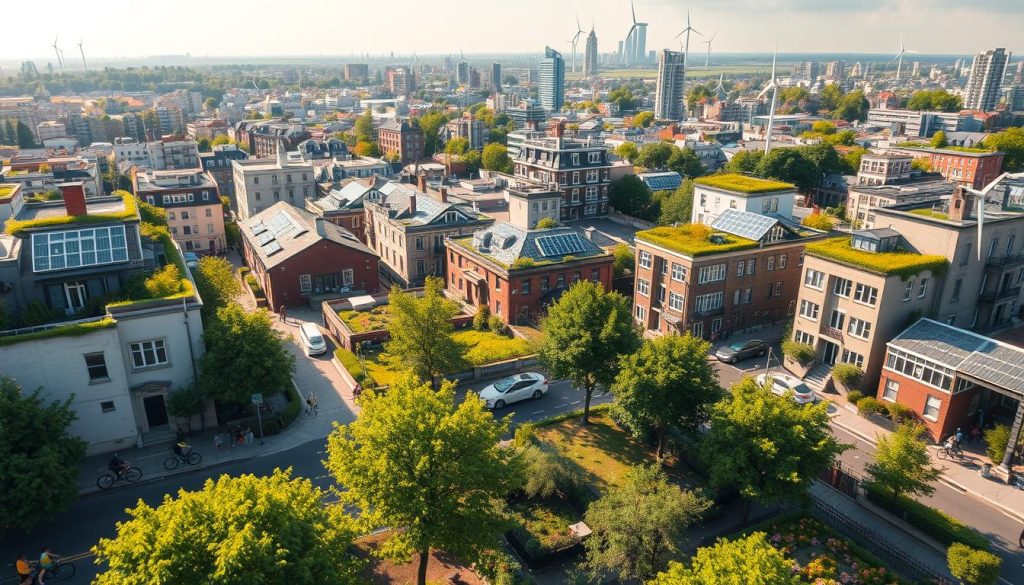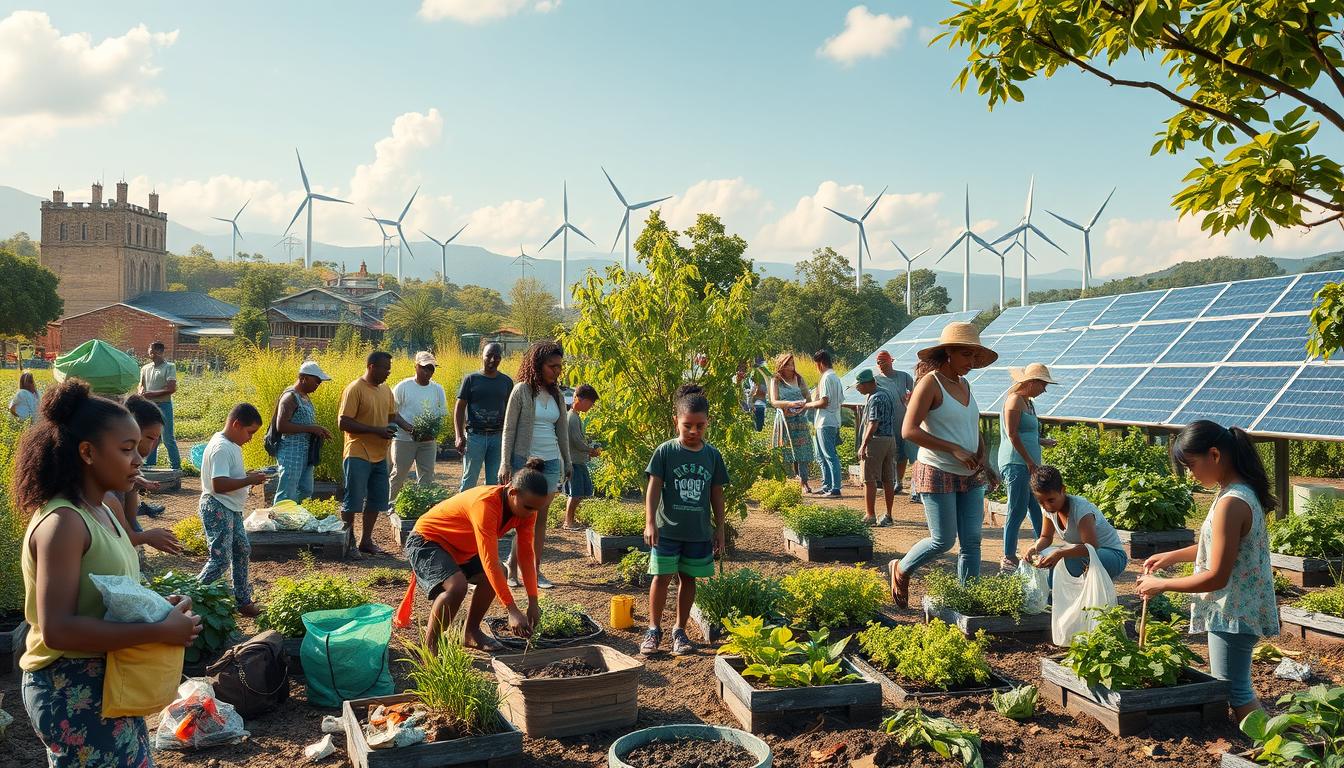I’m excited to invite you to join the growing movement for sustainability. Our planet is facing big environmental challenges, and we must act. Together, we can make a real difference and ensure a sustainable future for all.
Climate action is key in this movement. We can all help by reducing our carbon footprint and supporting green energy. Protecting the environment is crucial for our survival and the health of ecosystems around the world.
Let’s find ways to make a difference through advocacy, education, and daily actions. Are you ready to help solve these problems? Let’s work together to create a greener, cleaner world.
Understanding Advocacy for Sustainability
I’ve seen how advocacy is key for sustainable development. We face big environmental challenges today. It’s vital to know what sustainability means and how we can make a difference.
Defining Sustainability in Modern Context
Sustainability means meeting our needs without harming future generations. It’s about finding a balance between economic growth, social progress, and protecting the environment. This means using eco-friendly practices and supporting conservation efforts.
The Role of Advocacy in Driving Change
Advocates are crucial in pushing for sustainable policies and practices. They educate, lobby, and organize to raise awareness and inspire action. I’ve seen how individuals can make a big impact on businesses and governments to focus on sustainability.
Key Areas of Focus for Sustainability Advocates
Sustainability advocates focus on several key areas:
- Climate change mitigation
- Renewable energy adoption
- Waste reduction and recycling
- Biodiversity conservation
- Sustainable urban planning
By focusing on these areas, advocates work towards a sustainable future. Their efforts lead to new solutions and policy changes that help both people and the planet.
| Advocacy Area | Impact on Sustainability | Example Initiative |
|---|---|---|
| Climate Action | Reduces greenhouse gas emissions | Push for renewable energy policies |
| Resource Conservation | Preserves natural habitats | Campaigns against deforestation |
| Sustainable Cities | Improves urban living conditions | Promotion of green building standards |
The Urgent Need for Environmental Protection
Our planet is facing big challenges that need our immediate help. I’ve seen how important it is to protect the environment, take action on climate change, and save our natural resources. The Earth’s balance is at risk from human actions, and we must act fast to save it for the future.
Biodiversity loss is a major problem. Plants and animals are disappearing fast, harming ecosystems and food supplies. We need to protect habitats and use land wisely to stop this.
Pollution is a big problem in our air, water, and soil. We must push for stronger rules on pollution and waste. Using cleaner technologies and promoting recycling can greatly reduce harm to the environment.
Using up resources too quickly is another big issue. Our current ways of living are not sustainable, and we’re running out of resources fast. We must focus on renewable energy and save resources for the long term.
| Environmental Issue | Impact | Possible Solutions |
|---|---|---|
| Biodiversity Loss | Ecosystem disruption, food insecurity | Habitat preservation, sustainable land use |
| Pollution | Health risks, environmental degradation | Emission regulations, waste management |
| Resource Depletion | Scarcity, economic instability | Renewable energy, conservation strategies |
By acting now, we can lessen these threats and build a better future. It’s our responsibility to make a difference through our choices and working together for the environment.
Climate Action: From Awareness to Implementation
Climate action is now a global priority. I’ll look at the challenges, strategies, and success stories in fighting climate change.
Global Climate Change Challenges
We face rising temperatures, extreme weather, and sea-level rise. These issues harm ecosystems, economies, and health worldwide. We need global efforts to tackle these problems.
Effective Strategies for Climate Action
Here are some key strategies for climate action:
- Investing in renewable energy like solar and wind
- Using energy-efficient tech in buildings and transport
- Protecting and restoring natural ecosystems
- Promoting sustainable farming and reducing food waste
- Encouraging people to reduce their carbon footprint
Success Stories in Climate Mitigation
Many success stories show the impact of climate action. Here’s a table with some examples:
| Location | Initiative | Impact |
|---|---|---|
| Costa Rica | Reforestation efforts | Forest cover increased from 26% to 52% |
| Denmark | Wind energy development | 47% of electricity from wind power |
| Singapore | Green building mandates | 80% of buildings certified sustainable |
These examples prove we can make big changes with commitment and innovation. By using effective strategies and learning from successes, we can achieve a sustainable future.
Embracing Eco-Friendly Practices in Daily Life

I found that living eco-friendly is simpler than I thought. Making small changes has cut my carbon footprint and made me a better consumer. Let’s look at some easy ways to help the planet.
Starting with waste reduction is key. I use reusable bags, bottles, and containers. This has greatly reduced my plastic use. I also compost kitchen waste, making it into soil for my garden.
Energy and water conservation is now a habit. I turn off lights, unplug unused devices, and take shorter showers. These actions help the planet and save money on bills.
Choosing eco-friendly products is important. I pick items with less packaging and support green brands. When buying groceries, I choose local, organic foods. This cuts down on emissions and supports green farming.
| Area | Eco-Friendly Practice | Impact |
|---|---|---|
| Waste Reduction | Use reusable bags and containers | Decrease in plastic waste |
| Energy Conservation | Turn off unused lights and devices | Lower energy consumption |
| Water Conservation | Take shorter showers | Reduced water usage |
| Ethical Consumerism | Choose sustainable products | Support for eco-friendly businesses |
By adding these eco-friendly habits to my daily life, I’ve seen a big change. It’s rewarding to know my choices help create a greener future.
The Power of Renewable Energy in Sustainable Development
Renewable energy is key to a sustainable future. I’m excited to share how clean energy is shaping our world. Let’s explore the impact of green power on our planet.
Types of Renewable Energy Sources
There are many types of renewable energy. Solar panels use sunlight, wind turbines harness the breeze, and hydroelectric dams tap into water. Geothermal plants use Earth’s heat, and biomass converts organic matter to energy. These alternatives to fossil fuels are clean and diverse.
Benefits of Transitioning to Clean Energy
Switching to renewable energy has many benefits. It cuts down on greenhouse gas emissions, improving air quality and fighting climate change. It also creates jobs, boosts local economies, and enhances energy security. As technology improves, renewables become more affordable, making sustainable development possible for everyone.
Overcoming Barriers to Renewable Energy Adoption
Renewable energy faces challenges, like high initial costs and technology development. Issues like intermittency and storage limitations also exist. But I’m hopeful about the future.
Smart grids, better batteries, and supportive policies are helping. With more innovation and investment, green initiatives will change our energy landscape. They will lead us to a sustainable future.
Strategies for Carbon Footprint Reduction

I’m excited to share some effective strategies for reducing our carbon footprint. These can make a big difference in our fight against climate change. By adopting eco-friendly practices and focusing on sustainable development, we can all help create a greener future.
One of the most impactful ways to reduce our carbon footprint is by improving energy efficiency at home and work. This includes using LED bulbs, upgrading to energy-efficient appliances, and properly insulating buildings. These simple changes can lead to significant reductions in energy consumption and greenhouse gas emissions.
Transportation is another key area where we can make a difference. Opting for sustainable transportation options like walking, cycling, or using public transit can greatly decrease our individual carbon emissions. When driving is necessary, carpooling or switching to electric vehicles are excellent alternatives.
Responsible consumption habits play a crucial role in carbon footprint reduction. By choosing products with minimal packaging, buying local and seasonal produce, and reducing meat consumption, we can lower the environmental impact of our daily choices.
| Strategy | Potential CO2 Reduction (kg/year) | Implementation Difficulty |
|---|---|---|
| Switch to LED bulbs | 300 | Easy |
| Use public transportation | 2,000 | Moderate |
| Reduce meat consumption | 900 | Moderate |
| Install solar panels | 3,000 | Difficult |
By implementing these strategies, we can significantly reduce our carbon footprint and contribute to a more sustainable future. Every small action counts in our collective effort to combat climate change.
Green Initiatives: Making a Difference at the Local Level
I think local action is crucial for sustainable development. In my community, I’ve seen green initiatives change neighborhoods and inspire others. Let’s look at ways we can make a difference right where we live.
Community-based Sustainability Projects
I’ve joined several community gardens. They provide fresh produce and teach us about sustainable living. These gardens bring neighbors together, creating a sense of shared responsibility for our environment. Activities like composting workshops and seed swaps spread conservation efforts across the community.
Urban Greening and Its Impact
Urban greening has turned concrete jungles into green spaces. I’ve seen abandoned lots become pocket parks and rooftops turned into gardens. These green areas improve air quality, reduce heat, and increase biodiversity. They also make our cities more beautiful and livable.
Engaging Local Businesses in Green Practices
Local businesses are increasingly adopting eco-friendly practices. From using compostable cups to energy-efficient lighting, these changes are significant. By supporting these businesses, we encourage more to follow, leading to sustainable development in our local economy.
By focusing on these local green initiatives, we can make lasting changes. Every small action helps build more resilient, sustainable communities. Together, we can create a greener future.
Conservation Efforts: Preserving Biodiversity and Natural Resources

I’ve always been fascinated by the intricate web of life on our planet. Biodiversity is the key to a healthy ecosystem. Conservation efforts play a crucial role in maintaining it. As we face unprecedented environmental challenges, it’s more important than ever to focus on preserving our natural resources.
Conservation efforts come in many forms. From protecting endangered species to restoring habitats, these initiatives aim to safeguard our planet’s rich biodiversity. Environmental protection agencies work tirelessly to implement policies that support sustainable development while preserving our natural heritage.
One of the most effective ways to contribute to conservation is through local action. Here are some simple steps I take to make a difference:
- Planting native species in my garden
- Reducing water consumption
- Supporting local conservation organizations
- Educating others about the importance of biodiversity
Sustainable development is closely linked to conservation efforts. By finding ways to meet our needs without compromising future generations, we can create a balance between progress and environmental protection. This approach helps preserve biodiversity while allowing for economic growth.
| Conservation Area | Biodiversity Impact | Economic Benefit |
|---|---|---|
| Wetland Restoration | Increased habitat for aquatic species | Improved water quality, flood control |
| Forest Preservation | Protection of diverse plant and animal species | Carbon sequestration, eco-tourism |
| Marine Protected Areas | Recovery of fish populations | Sustainable fisheries, coastal protection |
By understanding the connection between conservation efforts, environmental protection, and sustainable development, we can work together to create a better future for all living beings on Earth.
Ethical Consumerism: Voting with Your Wallet
I think our buying choices can help make the world more sustainable. Ethical consumerism lets us support green practices and push for sustainable growth with our daily purchases.
Understanding Ethical Consumption
Ethical buying means picking items that match our values. It’s about thinking about the environmental and social effects of our shopping. By choosing items made responsibly, we cut down on pollution and back companies that care about the planet.
Identifying Sustainable Products and Services
To find green choices, I look for labels like Fair Trade, USDA Organic, or Energy Star. Reading labels and checking out brands helps me make smart picks. Important things I check are:
- Use of recycled or biodegradable materials
- Energy efficiency
- Minimal packaging
- Fair labor practices
The Impact of Consumer Choices on Sustainability
Our shopping habits send strong messages to companies. When we pick eco-friendly products, we show there’s demand for green options. This pushes businesses to use greener methods and invest in sustainable growth. By using our money wisely, we can help create a better future for everyone.
Advocacy for Sustainability: How to Get Involved and Make an Impact
I think everyone can help with sustainability. It’s not just big groups or governments. We all can make a difference. Start by learning about climate action and green projects. Read books, watch documentaries, and follow environmental groups online.
After learning, find local groups that care about the planet. Join a community garden, help with beach cleanups, or volunteer for green non-profits. These actions will teach you more and connect you with others who want to make a difference.
Social media is great for spreading the word. Share facts about sustainability, show off green successes, and motivate others to act. Every small choice you make can help. By living sustainably and encouraging others, you’re part of a bigger movement for change.
Your voice is very powerful. Write to your local leaders about green policies, support eco-friendly businesses, and talk to your friends and family about protecting the environment. Together, we can create a better future for everyone.
